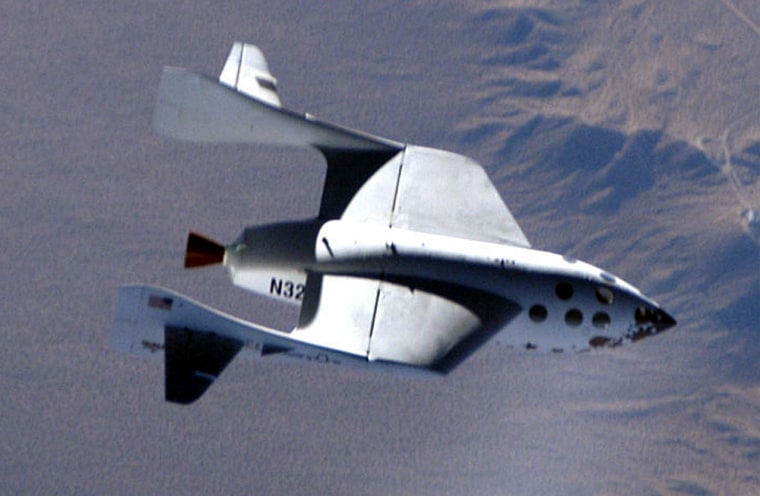A privately funded space race heated up Thursday, with a second supersonic flight test by the front-runner and word that at least two teams will be scheduling launches aimed at winning the $10 million X Prize.
Scaled Composites' SpaceShipOne rocket plane conducted a "perfect rocket-powered flight" on Thursday, according to an announcement from the St. Louis-based X Prize Foundation, which is in charge of the suborbital spaceflight competition.
The Scaled Composites team, led by famed aviation designer Burt Rutan and financed by high-tech billionaire Paul Allen, conducts its tests from the Civilian Flight Test Center in Mojave, Calif. The rocket plane was carried into the desert skies attached to its White Knight mothership, then released for the rocket-powered phase of its flight.
SpaceShipOne soared to an altitude of 105,000 feet (32 kilometers) and achieved a top speed of approximately Mach 2, or two times the speed of sound, the X Prize Foundation said. The craft then glided to a landing at the Mojave airstrip.
The X Prize Foundation's account of the flight test, based on reports from foundation executives visiting Mojave, was first published by Space.com. Scaled Composites' spokeswoman, Kaye LeFebvre, told MSNBC.com that information about Thursday's flight would not be posted on the company's Web site until the test results had been reviewed by the SpaceShipOne team. She declined further comment.
The X Prize statement, however, said that SpaceShipOne's second powered flight was piloted by Peter Siebold, and that the craft's hybrid rocket engine burned for 40 seconds.
Go-ahead for extended tests
SpaceShipOne and the White Knight have gone through a variety of less ambitious tests since their rollout last April. The first rocket-powered flight came on Dec. 17, the 100th anniversary of the Wright brothers' historic flight at Kitty Hawk, N.C. During December's flight, SpaceShipOne's engine burn lasted 15 seconds and pushed the rocket plane to supersonic speed.
At the time, that was as much as the plane could do under federal regulations. But on Wednesday, the Federal Aviation Administration announced that its Office of Commercial Space Transportation issued a launch license to Scaled Composites for suborbital tests over the next year. That license cleared the way for Thursday's extended test.
The U.S. Department of Transportation, which oversees the FAA, said the license was the first ever issued for suborbital manned rocket flights. FAA sources told MSNBC.com that two other applications for such licenses, from Xcor Aerospace and Armadillo Aerospace, were still being considered. Armadillo is another front-runner for the X Prize, while Xcor has opted not to compete.
Big year for the X Prize
The X Prize is aimed at encouraging the development of commercial space travel — following the model set by the $25,000 Orteig Prize, which was won by trans-Atlantic aviator Charles Lindbergh in 1927. Twenty-seven teams from seven countries have registered for the competition. The $10 million prize would go to the first team that sends a privately financed craft capable of carrying three people to an altitude of 100 kilometers (62 miles), then repeats the feat within two weeks.
A hundred kilometers is considered the edge of outer space, where suborbital passengers would feel a sense of weightlessness and see the curvature of the earth against a black sky. SpaceShipOne's flight on Thursday took it to about a third of that altitude. The X Prize statement indirectly referred to that distance disparity when it quoted an unnamed witness as exclaiming, "105,000 feet down, 223,000 feet to go!"
Under the X Prize Foundation's current financial arrangements, which involve private donations and an insurance policy, the $10 million purse disappears at the end of 2004. That's what's fueling the rising tide of activity this spring.
Announcements pending
Teams are required to notify the foundation about an impending X Prize attempt 60 days in advance. X Prize spokesman Ian Murphy told MSNBC.com on Monday that Scaled Composites is expected to reveal its schedule on May 5 during an event organized by the foundation. Previously, dates in April had been under discussion for the announcement.
Murphy did not provide information on the venue for the announcement, and he cautioned that the event was not necessarily tied to the 60-day window.
Murphy said at least one more X Prize team was expected to announce its launch schedule. Press reports have indicated the second team is the Canadian-based da Vinci Project. The da Vinci team plans to use a piloted helium balloon to carry its rocket to an altitude of 80,000 feet. The rocket would be released, blast its way to an altitude of about 75 miles (120 kilometers), then float to a parachute landing.
Brian Feeney, leader of the da Vinci Project, confirmed that his team was planning a launch this summer from Kindersley in the prairie province of Saskatchewan, but he declined to be more specific during an interview Thursday.
